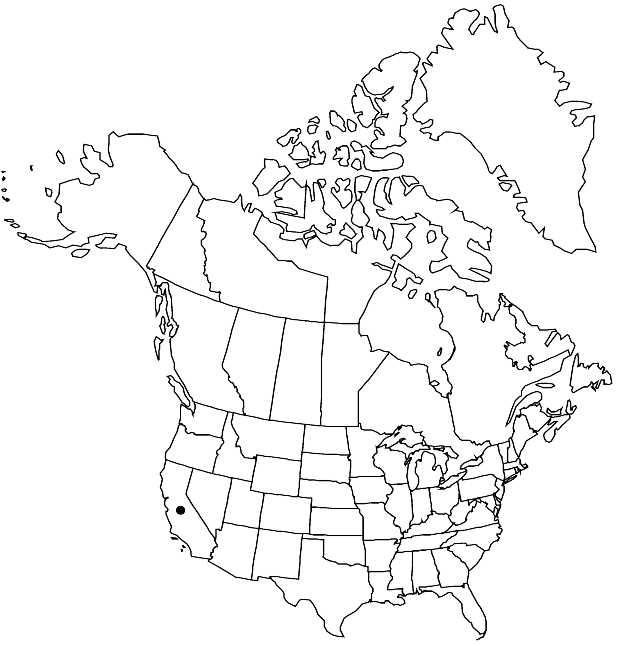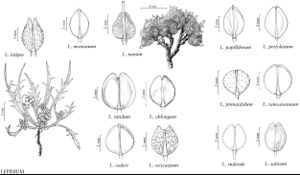Difference between revisions of "Lepidium pinnatifidum"
Fl. Ross. 1: 206. 1841.
FNA>Volume Importer |
imported>Volume Importer |
||
| (5 intermediate revisions by 2 users not shown) | |||
| Line 6: | Line 6: | ||
|place=1: 206. 1841 | |place=1: 206. 1841 | ||
|year=1841 | |year=1841 | ||
| + | }} | ||
| + | |special_status={{Treatment/ID/Special_status | ||
| + | |code=I | ||
| + | |label=Introduced | ||
| + | }}{{Treatment/ID/Special_status | ||
| + | |code=F | ||
| + | |label=Illustrated | ||
}} | }} | ||
|basionyms= | |basionyms= | ||
| Line 23: | Line 30: | ||
|elevation=0-600 m | |elevation=0-600 m | ||
|distribution=Calif.;e Europe;w Asia. | |distribution=Calif.;e Europe;w Asia. | ||
| + | |introduced=true | ||
|discussion=<p><i>Lepidium pinnatifidum</i> apparently has not become a serious weed of the Californian flora.</p> | |discussion=<p><i>Lepidium pinnatifidum</i> apparently has not become a serious weed of the Californian flora.</p> | ||
|tables= | |tables= | ||
| Line 32: | Line 40: | ||
-->{{#Taxon: | -->{{#Taxon: | ||
name=Lepidium pinnatifidum | name=Lepidium pinnatifidum | ||
| − | |||
|authority=Ledebour | |authority=Ledebour | ||
|rank=species | |rank=species | ||
| Line 47: | Line 54: | ||
|publication title=Fl. Ross. | |publication title=Fl. Ross. | ||
|publication year=1841 | |publication year=1841 | ||
| − | |special status= | + | |special status=Introduced;Illustrated |
| − | |source xml=https:// | + | |source xml=https://bitbucket.org/aafc-mbb/fna-data-curation/src/2e0870ddd59836b60bcf96646a41e87ea5a5943a/coarse_grained_fna_xml/V7/V7_958.xml |
|tribe=Brassicaceae tribe Lepidieae | |tribe=Brassicaceae tribe Lepidieae | ||
|genus=Lepidium | |genus=Lepidium | ||
Latest revision as of 22:37, 5 November 2020
Annuals; puberulent. Stems simple from base, erect, (paniculately) branched beyond base or distally, 2–6 dm. Basal leaves (soon withered, often before anthesis); not rosulate; blade dentate to pinnatifid. Cauline leaves shortly petiolate to subsessile; blade narrowly oblanceolate to linear, 1–3.3 cm × 1–4 mm, base attenuate, not auriculate, margins entire. Racemes (often paniculate), considerably elongated in fruit; rachis glabrous or puberulent, trichomes straight, cylindrical. Fruiting pedicels divaricate-ascending to horizontal, straight, (terete), 2–3.5 × 0.1–0.15 mm, puberulent adaxially. Flowers: sepals oblong, 0.7–0.8 × 0.3–0.4 mm; petals (rudimentary), white, linear, 0.4–0.6 × 0.05–0.1 mm, claw absent; stamens 4, median and lateral; filaments 0.6–0.8 mm; anthers ca. 0.2 mm. Fruits orbicular to broadly elliptic, 1.8–2 × 1.7–1.8 mm, apically not winged, apical notch 0.05–0.1 mm deep; valves thin, smooth, not veined, sparsely pilose; style ca. 0.1 mm, equaling apical notch. Seeds oblong, 1–1.2 × 0.7–0.8 mm.
Phenology: Flowering May–Jun.
Habitat: Waste places, disturbed sites
Elevation: 0-600 m
Distribution

Introduced; Calif., e Europe, w Asia.
Discussion
Lepidium pinnatifidum apparently has not become a serious weed of the Californian flora.
Selected References
None.
